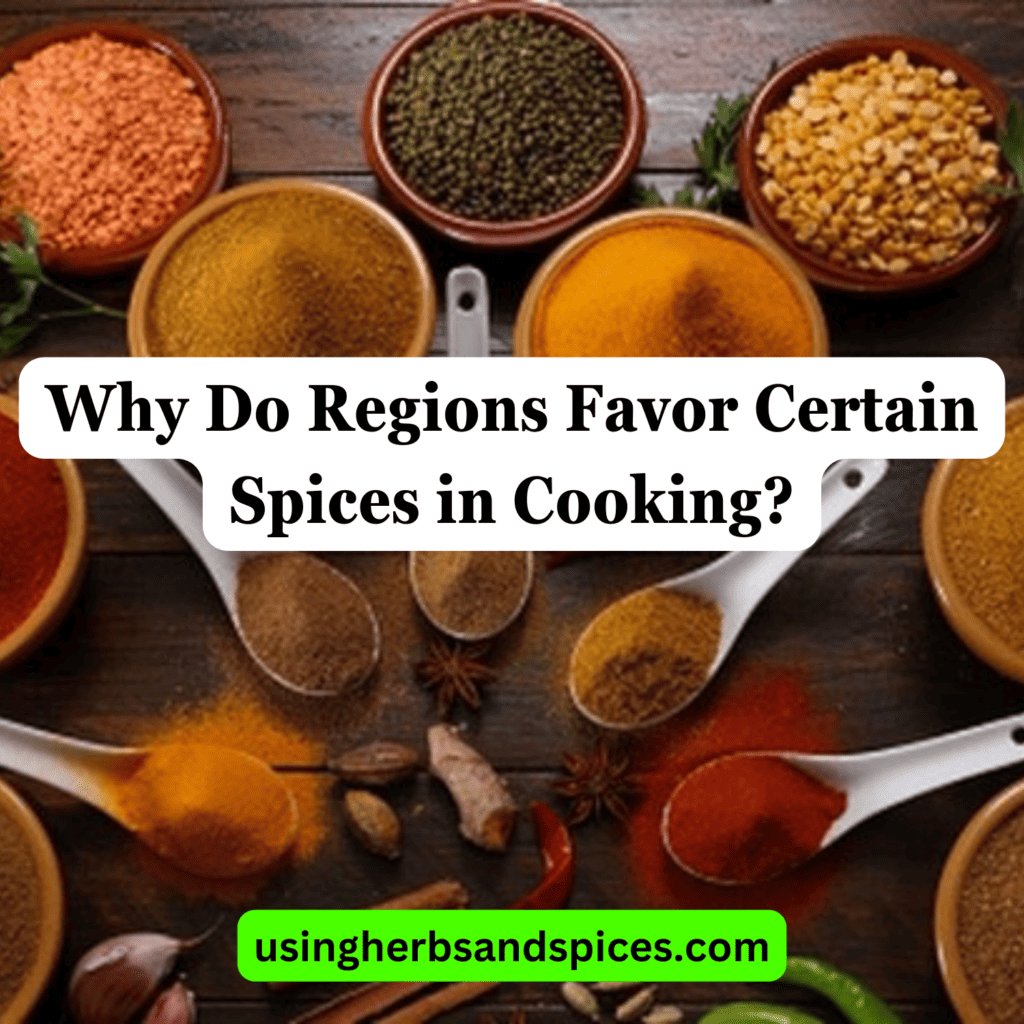As you walk through the tapestry of global cuisines, you’ll find that each region weaves its unique flavor with a special blend of spices. You’re part of a community that shares the love for the warmth of cinnamon or the kick of chili, and it’s no accident these spices feel like home.

They’re deeply rooted in the local soils that nurture them and in traditions that have been passed down for generations. Your palate is a reflection of the climate you live in, the economy that sustains you, and the history that has shaped you.
The spices you favor in your cooking tell a story of who you are and where you belong, connecting you to your region’s cultural heritage and communal taste preferences.
Table of Contents
Key Takeaways
- Spice monopolies in history influenced the prices, accessibility, and symbolism of spices, leading to certain spices becoming symbols of status and belonging to a more affluent class.
- The climate and agriculture of a region play a significant role in shaping regional cuisine preferences, with specific spices thriving in specific climates and agricultural techniques evolving to maximize spice yield and quality.
- Cultural factors, such as historical trade routes, festive occasions, and taste preferences that evolve over generations, contribute to the association between certain spices and communal belonging and the pairing of spices with local ingredients to enhance flavors.
- Economic factors, including regional monopolies, trade barriers, and transport costs, continue to shape spice availability in local markets, leading to limited variety and increased value of certain spices. Additionally, emphasis is placed on native spices and traditional flavor profiles based on local availability.
Historical Spice Trade Impact
You can trace the distinct flavors of regional cuisines back to the historical spice trade, which left a lasting impact on local food cultures around the world. Spice monopolies controlled supply and demand, influencing not only prices but also accessibility. Such control meant that spices, once exclusive and expensive, became symbols of status; possessing them meant you were connected, you belonged to a more affluent class.
The lust for these flavors spurred exploration incentives, pushing nations to voyage across uncharted waters, seeking new routes and territories. As explorers established trade links, spices began to weave their way into the fabric of local cuisines. They didn’t just add flavor; they became a means of expressing community identity and pride.
Certain spices that were abundant or exclusive to an area became staples, shaping the culinary landscape. For instance, the affinity for nutmeg in Indonesian cooking or black pepper in South Indian dishes isn’t incidental; it’s a narrative of their historical trade relationships.
Through this lens, you’re not just tasting a region’s food; you’re savoring a chapter of its history. Every time you indulge in these spices, you’re a part of a centuries-old global connection, a testament to the power of flavor that unites us all.
Local Climate and Spice Growth
Beyond their historic trade value, spices thrive in specific climates, shaping regional cuisine preferences due to the local growing conditions. You’re part of a community that shares a culinary identity, often defined by the flavors that are grown right in your backyard. The heat and humidity of tropical regions are ideal for growing vibrant spices such as cardamom, vanilla, and pepper. Meanwhile, temperate climates favor the cultivation of herbs like rosemary and thyme. Each spice’s unique requirement for sunlight, soil, and temperature means that they’re not just plants, but symbols of your home’s natural heritage.
Agricultural techniques have evolved to maximize the yield of these precious commodities. Through selective breeding and careful cultivation, the spices you love aren’t only preserved but enhanced in quality. Spice preservation, too, is a craft honed by your ancestors, allowing flavors to be stored and savored year-round, despite seasonal changes.
This deep-rooted connection between local climate, spice growth, and agricultural savvy forms the bedrock of your region’s gastronomic culture. It’s a testament to how you and your community have adapted to the earth’s diverse palette, creating a sense of belonging through the shared language of taste.
Cultural Taste Preferences
Tradition dictates your region’s palate, often reflecting a tapestry of historical influences and social customs through the spices that season your meals. These culinary practices contribute to your community’s flavor identity, a signature blend that sets your cuisine apart from others. Over generations, your taste preferences evolve, leading to a phenomenon called sensory adaptation, where the flavors you’re repeatedly exposed to become preferred and even comforting.
To understand why these preferences exist, consider the following:
- Historic Trade Routes: Your ancestors’ access to certain spices was determined by ancient trade connections. These routes brought specific flavors into your cultural fold, which became entrenched over time.
- Cultural Celebrations: Festive occasions often call for traditional recipes that are handed down, reinforcing the association between certain spices and communal belonging.
- Local Produce Synergy: Spices are often paired with local ingredients to enhance their flavors, creating a harmonious balance tailored to what’s readily available in your region.
Your cultural taste preferences are more than just habits; they’re a reflection of your community’s history, environment, and social bonds. As you sit down to dine, remember that each spice in your dish carries a story that connects you to a larger, flavorful heritage.
Economic Factors and Availability
Your region’s spice preferences are often shaped by economic factors and the availability of certain ingredients throughout history. Regional monopolies on certain spices have dictated not only the use but also the significance these flavors have within your local cuisine. It’s not just about what grows nearby; it’s also about what your region could afford to import or trade.
Historically, trade barriers such as tariffs and long-distance transport costs made some spices less accessible to certain areas, reinforcing regional tastes based on what was readily available and affordable. Even today, economic accessibility continues to influence which spices you find in your local markets and, subsequently, in your kitchen.
To understand this better, let’s look at a simple breakdown:
| Factor | Impact on Spices | Example |
|---|---|---|
| Regional Monopolies | Limited variety; increased value of certain spices | Nutmeg in the Banda Islands |
| Trade Barriers | Restricted access; higher costs for imports | Saffron during trade sanctions |
| Local Availability | Emphasis on native spices; traditional flavor profiles | Chili peppers in South America |
Traditional Recipes and Techniques
As you delve deeper into your culinary heritage, you’ll notice that historic recipes and cooking methods have also played a crucial role in cementing the spices that define your region’s signature dishes. The spices chosen in these recipes aren’t arbitrary; they’re a testament to the ingenuity of your ancestors in flavor preservation and their adaptability through ingredient substitutions.
Here’s how traditional recipes and techniques have shaped your region’s palate:
- Continuity of Culture: Classic dishes serve as a vessel for history, with each spice offering a narrative of past trade routes, invasions, and migrations that have subtly influenced your regional cuisine.
- Flavor Preservation: Over generations, methods like pickling, fermenting, and drying have been perfected to not only preserve food but also to enhance its taste. The spices used in these processes were selected for their ability to thrive under these conditions and elevate the flavor profile.
- Adaptable Substitutions: When certain ingredients were unavailable, your forebears made do with what was at hand, leading to the incorporation of local spices that could mimic or even surpass the original flavor intended in the recipe.
Understanding this, you become more than just a consumer of your cuisine; you’re a guardian of a rich, flavorful legacy that’s been simmering for centuries.
Frequently Asked Questions
How Do Modern Transportation and Globalization Affect Regional Spice Preferences Today?
Modern transportation and globalization have reshaped the spice trade history, making exotic flavors accessible everywhere. You’re witnessing a blending of flavor adaptation trends, fostering a sense of culinary belonging in our global village.
Are There Any Health Benefits or Risks Associated With the Consumption of Region-Specific Spices?
You’re spicing up your life, but at what cost? Spice economics reveals some spices boost health, while others risk it, influencing cultural palates. You’re part of a flavorful tapestry, woven with wellness and tradition.
How Do Language and Communication Barriers Influence the Spread and Adoption of Spices in Different Regions?
You’ll find that spice linguistics and flavor communication are complex due to language barriers, hindering the sharing of spice uses and preferences, making it harder for you to feel connected to diverse culinary traditions.
What Is the Role of Innovation and Experimentation in the Evolution of Regional Spice Usage?
You’re blending tradition with innovation, where spice fusion embodies culinary creativity. Your experimentation ushers in new flavors, reflecting an analytical, descriptive evolution in regional spice use, fostering a sense of belonging through shared, bold tastes.
How Do Personal and Family Traditions Shape and Preserve the Use of Certain Spices Within Communities?
Your family’s recipes, steeped in heritage, become part of your culinary identity, preserving traditions through each spice chosen. These selections foster a sense of belonging while honoring your community’s storied palate.
Regions Favor Certain Spices in Cooking
You’ve ventured through the spice-laden paths of history, felt the heat and humidity that cradle exotic flavors, and tasted cultural delights shaped over centuries.
Ironically, while your kitchen brims with global spices, your local dishes likely cling to tradition, shaped more by old trade routes and grandma’s cookbook than by the globalized supermarket aisles.
So next time you sprinkle that familiar spice, remember—it’s not just flavor, it’s a tale of trade winds, ancestral pots, and perhaps, economic serendipity.
